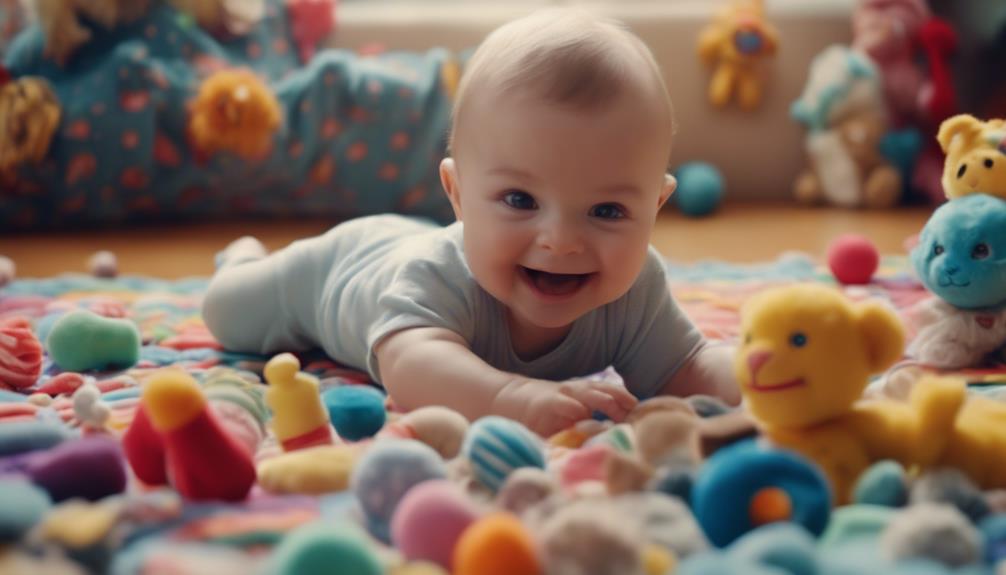Sensory playtime with messy games is a fantastic way to spark your baby’s curiosity and boost their development. By exploring textures like slime, sand, or water, your little one enhances fine motor skills, hand-eye coordination, and sensory discrimination. Messy play also encourages confidence and resilience through safe exploration. You’ll love watching them learn and grow as they engage with exciting, tactile activities. Keep exploring more ways to make sensory play both fun and educational for your baby.
Key Takeaways
- Incorporate textured materials like slime, sand, and fabric to stimulate tactile exploration and neural development.
- Embrace messy activities such as finger painting or water splashing to encourage curiosity and sensory engagement.
- Use a variety of textures to enhance motor skills, object recognition, and sensory discrimination.
- Adapt activities to individual preferences, promoting confidence and resilience through safe messiness.
- Combine sensory play with fine motor tasks for comprehensive development and fun learning experiences.

Sensory playtime offers children a hands-on way to explore and understand their environment, stimulating their senses and fostering development. When you encourage tactile exploration, you’re helping your baby build essential skills that support their sensory development. These activities engage their sense of touch, which is vital for learning about textures, temperatures, and materials. As your little one squishes, pats, or brushes different surfaces, they’re not just having fun—they’re developing the nerve pathways that will help with later tasks like writing, grasping, and recognizing objects. This active engagement promotes neural growth, laying a foundation for more complex skills down the line.
By providing a variety of textures—think soft fabrics, rough sandpaper, cool gel packs, or squishy slime—you give your baby the opportunity to experience a wide range of sensations. This kind of tactile exploration is essential because it helps children understand their environment more fully. When they feel different textures, they begin to associate certain sensations with objects or concepts, which enhances their cognitive development. Plus, tactile play can improve their fine motor skills as they grasp, squeeze, or manipulate different materials. This not only boosts their sensory development but also strengthens their hand-eye coordination and finger dexterity.
Providing various textures enhances sensory and cognitive development while strengthening fine motor skills and hand-eye coordination.
It’s important to remember that messy games are a natural part of sensory play and should be embraced, not avoided. Whether it’s finger painting with bright colors, playing with textured dough, or splashing in water, these activities invite your child to use their hands freely. Messy play encourages curiosity and risk-taking, essential for learning resilience and problem-solving. As you facilitate these activities, stay observant of how your baby responds to different textures—some might love squishy, while others prefer smooth or grainy. This feedback helps you tailor future sensory experiences to suit your child’s preferences and developmental needs.
Furthermore, sensory playtime isn’t just about indulging in fun; it’s about fostering a rich learning environment. You can incorporate activities that challenge their tactile senses and promote sensory integration. For instance, hiding small objects in textured boxes or encouraging them to identify materials by touch develops both tactile skills and cognitive association. These experiences also serve as a calming activity when your baby feels overwhelmed, providing comfort through familiar textures and gentle sensory input.
Frequently Asked Questions
When Should I Introduce Sensory Play to My Baby?
You should introduce sensory play when your baby reaches their sensory milestones, usually around 4 to 6 months. Make sure to choose safe materials that are non-toxic and age-appropriate to prevent choking or allergic reactions. Start with simple activities like textured fabrics or water play, and always supervise. This helps your baby explore safely, develop their senses, and build important skills early on.
How Do I Ensure Sensory Activities Are Safe for My Baby?
To guarantee sensory activities are safe for your baby, always use non-toxic materials and check for any small parts that could be a choking hazard. Supervision tips include staying close and watching your baby closely during play, especially with messy or textured items. Keep the area clean and organized, and avoid anything that might cause allergies or irritation. By taking these precautions, you create a safe, fun environment for your little one to explore.
What Are Some Age-Appropriate Sensory Play Ideas?
Did you know that babies learn best through hands-on exploration? For age-appropriate sensory play ideas, start with texture exploration by offering soft fabrics or squishy toys. Sensory bins filled with safe, varied materials like rice or pasta encourage curious hands to discover different textures. These activities promote development while engaging your baby in fun, safe ways. Always supervise to guarantee safety and keep the experience positive and enriching.
Can Sensory Play Help With My Baby’s Development Milestones?
Sensory play can markedly boost your baby’s development milestones by encouraging tactile exploration and supporting cognitive development. When your baby engages with different textures, they build essential sensory skills and problem-solving abilities. You actively promote their growth by offering varied sensory experiences, which help them understand their environment better. This hands-on approach not only makes learning fun but also strengthens neural connections, paving the way for future learning and development.
How Do I Clean up After Messy Sensory Activities?
Messy play can seem overwhelming, but with simple clean-up strategies, it’s manageable. You can prep by laying down a plastic sheet or towels to minimize mess and make clean-up easier. Keep wipes, paper towels, and a damp cloth nearby for quick mess minimization. After play, rinse or wash toys and surfaces promptly to prevent stains. Embrace the mess, knowing these strategies make clean-up quick and stress-free.
Conclusion
Now that you know the magic of sensory play, think of it as revealing a treasure chest of exploration for your baby. These messy games aren’t just fun—they’re the keys to their growing world, unlocking new senses and skills. Embrace the mess as part of the adventure, and watch your little one blossom like a beautiful garden after rain. With each messy moment, you’re nurturing curiosity and joy that will last a lifetime.










